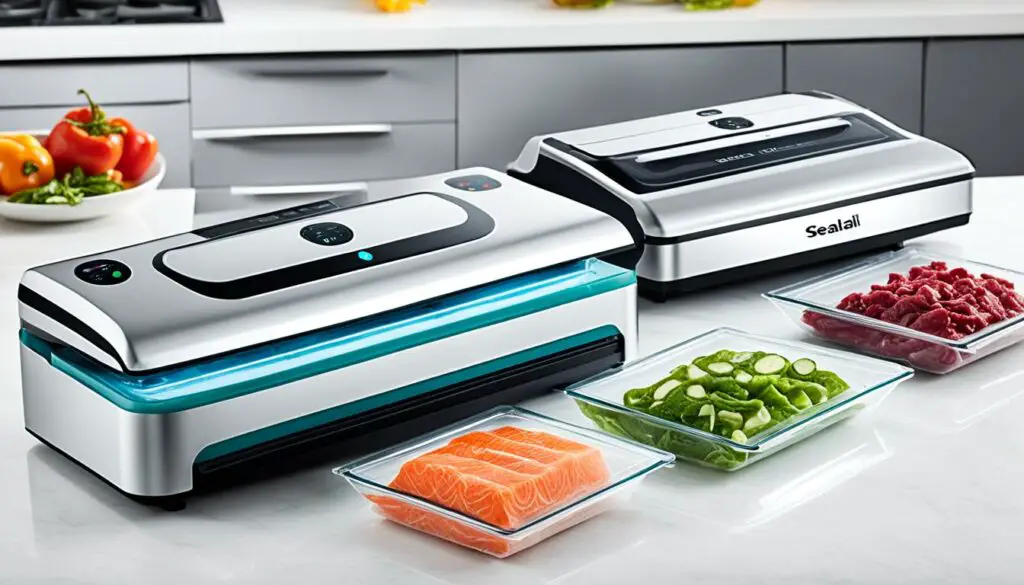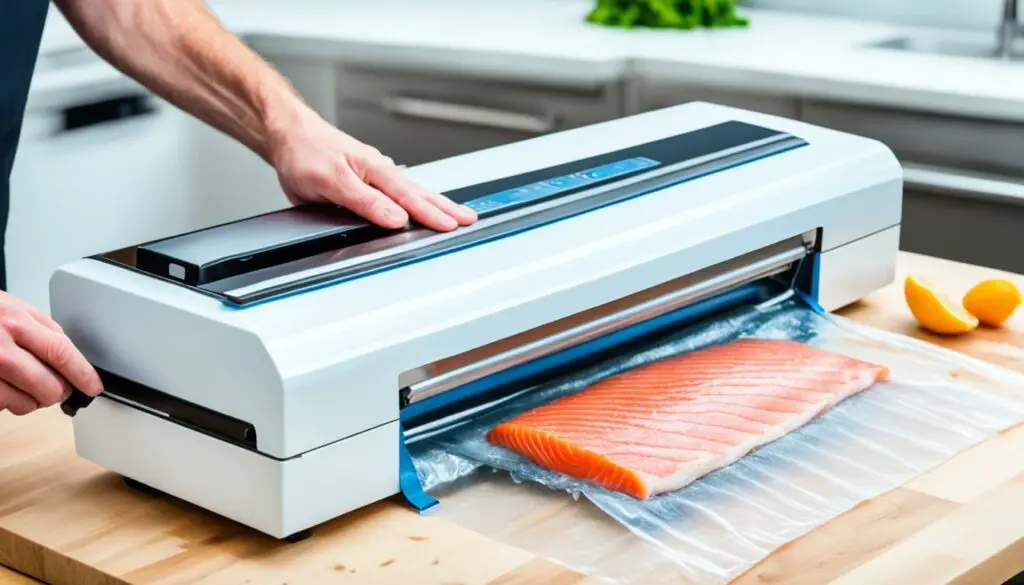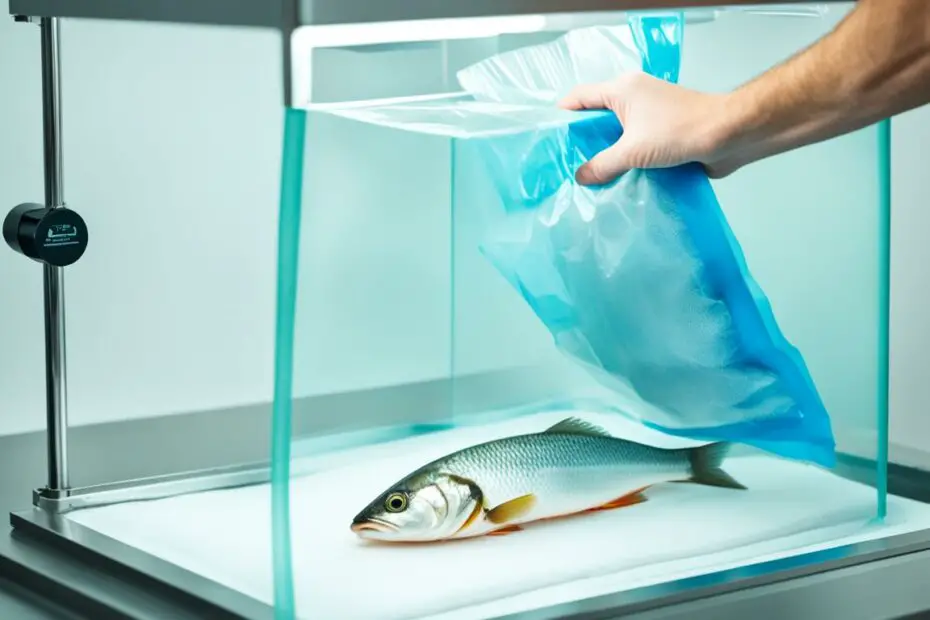Imagine returning from a successful fishing trip with a cooler full of delicious, fresh fish. The excitement of the catch is palpable as you anticipate the mouthwatering meals that await. However, you know that fish can quickly lose its freshness if not properly stored. That’s where the art of vacuum sealing comes in.
With the right knowledge and techniques, you can extend the shelf life of your fish and preserve its original flavor and texture for months to come. Vacuum sealing is a highly effective method that removes oxygen and moisture from the packaging, significantly reducing the chances of freezer burn and spoilage.
In this article, we will guide you through the step-by-step process of vacuum sealing fish, exploring different sealing techniques, tips for optimal preservation, and the advantages of vacuum sealing fish. Whether you’re an avid angler or simply looking to make the most of your catch, this comprehensive tutorial will equip you with the necessary knowledge to seal your fish like a pro.
The Importance of Vacuum Sealing for Long-Term Fish Preservation
Vacuum sealing is essential for long-term fish preservation, ensuring that fish remains fresh and flavorful even after extended periods of storage. By removing oxygen and moisture, vacuum sealing eliminates the primary factors that cause food to spoil and expire. This preservation method extends the shelf life of fish in the freezer, preventing freezer burn and maintaining its quality for up to 1-2 years.
When fish is exposed to air and moisture, it can quickly deteriorate, leading to unpleasant odors, discoloration, and freezer burn. Freezer burn occurs when moisture in the fish turns into ice crystals, causing dehydration and affecting the texture and taste. However, by vacuum sealing fish, the oxygen and moisture are effectively removed from the packaging, creating an airtight seal that protects the fish from these harmful elements.
Vacuum sealing not only prevents food waste by preserving the fish, but it also offers distinct advantages. The fish retains its original flavor and texture, allowing anglers to enjoy their catch as if it were just caught. Whether it’s a freshly caught salmon or a prized tuna, vacuum sealing ensures the fish maintains its unmatched taste and texture. Additionally, by vacuum sealing fish, anglers can store and preserve larger quantities of fish efficiently, making it an ideal method for those who enjoy fishing and want to enjoy their catch over an extended period.
With vacuum sealing, anglers can enjoy the convenience of having fish readily available whenever they desire, without compromising on quality. Whether it’s for a special occasion or a quick and delicious meal, vacuum-sealed fish offers the flexibility of long-term storage without sacrificing taste and freshness.
Choosing the Right Vacuum Sealer for Your Needs
When it comes to preserving fish, choosing the right vacuum sealer is crucial for ensuring optimal storage and freshness. With various types and features available, anglers must assess their options to make an informed decision. This section will explore the different types of vacuum sealers and provide a guide for assessing the features necessary for fish storage. Take a closer look at the options available below:
Different Types of Vacuum Sealers
There are two main types of vacuum sealers: external suction sealers and chamber vacuum sealers. Consider the following differences:
- External Suction Sealers: These sealers, such as the popular FoodSaver style sealers, are compact and affordable options suitable for home use. They provide decent results for preserving fish and are easy to operate.
- Chamber Vacuum Sealers: While larger and more expensive, chamber vacuum sealers offer advanced features. They are capable of vacuum sealing liquids and can seal multiple bags in a single cycle. These sealers are ideal for commercial or high-volume use.
By understanding the differences between these vacuum sealer types, anglers can determine which option best suits their specific needs.
Assessing Vacuum Sealer Features for Fish Storage
When selecting a vacuum sealer for fish storage, certain features should be considered to ensure effective preservation. The following features are particularly important:
- Sealing Strength: A vacuum sealer with strong sealing capabilities ensures airtight packaging, preventing air and moisture from entering the bag and compromising fish quality.
- Speed: Efficiency is key when vacuum sealing fish. Look for a vacuum sealer that offers fast sealing times without sacrificing quality.
- Durability: The durability of a vacuum sealer is essential for long-term use. Select a model that is built to withstand frequent sealing and can withstand the demands of fish storage.
- Compatibility with Specialized Vacuum Seal Bags: Different types of vacuum seal bags may be required for fish storage. Ensure that the vacuum sealer is compatible with the specific bags designed for preserving fish.
By assessing these key features, anglers can narrow down their choices and select a vacuum sealer that meets their specific fish storage needs.

Preparatory Steps Before Vacuum Sealing Fish
Before vacuum sealing fish, there are several important preparatory steps that should be followed to ensure optimal preservation.
First, it is crucial to ensure that the fish fillets are completely dry before placing them in the vacuum seal bag. Any moisture present can compromise the sealing process and lead to spoilage. To achieve dry fillets, it is recommended to thoroughly dry the fish with paper towels.
Additionally, anglers should carefully check for and remove any bones from the fish fillets. Protruding bones can puncture the vacuum seal bag, allowing air and moisture to enter and spoil the fish. Taking the time to meticulously examine and remove any bones will help to avoid potential issues during the vacuum sealing process.
Properly preparing the fish before vacuum sealing is essential to enhance the effectiveness of the preservation process and ensure the fish remains fresh and flavorful for an extended period.
“Before vacuum sealing fish, ensure that the fillets are completely dry and carefully remove any bones. These preparatory steps contribute to the effectiveness of the preservation process.”
How to Vacuum Seal Fish
The process of vacuum sealing fish involves several steps to ensure optimal preservation. Follow this step-by-step guide for vacuum sealing fish:
- Select the appropriate vacuum sealer for your needs.
- Ensure that the sealing bag is dry to prevent moisture from compromising the sealing process.
- Thoroughly dry the fish fillets with paper towels to remove excess moisture.
- Place the dried fish fillets in the vacuum seal bag, being careful not to overfill it. Overfilling the bag can make it challenging to remove air and moisture.
- Seal the bag shut using the vacuum sealer’s thermal bonding feature or other appropriate sealing method.
- Label the vacuum-sealed bag and store it in the freezer to maintain the fish’s freshness and flavor.
Following these step-by-step instructions will ensure that the fish is properly vacuum sealed for optimal preservation.

Ensuring Optimal Preservation with Effective Sealing Tips
To ensure optimal preservation of fish through vacuum sealing, it is important to follow certain tips and avoid common mistakes. By doing so, anglers can maximize the benefits of vacuum sealing and enjoy fresh-tasting fish even after extended periods of storage.
Avoiding Common Mistakes in Fish Vacuum Sealing
There are several common mistakes that anglers should avoid when vacuum sealing fish:
- Overfilling the vacuum seal bag: Overfilling the bag can make it difficult to remove air and moisture, compromising the effectiveness of the sealing process. It is important to leave enough space in the bag for proper sealing.
- Stacking fish fillets: Stacking fish fillets in the vacuum seal bag can create air pockets and prevent the bag from properly sealing. It is best to arrange the fillets in a single layer to ensure even sealing.
The Role of Proper Thawing Techniques
In addition to avoiding common mistakes, proper thawing techniques play a crucial role in preserving the quality of vacuum-sealed fish:
- Thaw fish in the refrigerator: It is recommended to thaw fish in the refrigerator rather than at room temperature. This slow thawing process helps prevent moisture absorption and maintains the flavor and texture of the fish.
- Minimize moisture loss: When thawing fish, it is important to minimize moisture loss by placing the fish in a sealed bag or container to prevent drying out.
By following these sealing tips and techniques and taking proper thawing precautions, anglers can ensure that their vacuum-sealed fish stays fresh and delicious for an extended period of time.
Brining Fish for Enhanced Texture and Freshness
The Science Behind Brining Fish Before Freezing
Brining fish before freezing is a technique that enhances the texture and freshness of the fish. Brining involves soaking the fish in a saltwater solution for a specific period. The salt in the brine penetrates the cells of the fish, preventing excess water from entering the cells and causing crystallization during the freezing process. This brining process results in firmer fish with minimized moisture loss.
The scientific explanation behind fish brining lies in the osmosis process, where salt ions balance the osmotic pressure, maintaining the moisture and texture of the fish. When the fish is immersed in the brine, the salt concentration outside the fish is higher than inside, causing water molecules to move out of the fish through osmosis to equalize the concentration. This prevents the cells from bursting or becoming dehydrated during freezing and thawing.
By understanding the science behind brining, anglers can utilize this technique to improve the quality of their vacuum-sealed fish. Brining not only enhances the texture and juiciness of the fish but also helps to preserve its flavor and prevent moisture loss during freezing. The process of brining fish before freezing is a vital step in ensuring that vacuum-sealed fish remains fresh and delicious for extended periods of time.
Vacuum Sealing Techniques for Different Types of Fish
When it comes to vacuum sealing fish, different types of fish require specific techniques to ensure optimal preservation. By understanding the unique characteristics and needs of each fish variety, anglers can tailor their vacuum sealing methods for the best results.
Fatty fish such as tuna and salmon have a shorter freezer life compared to lean, white fish like haddock and black sea bass. It is advisable to consume fatty fish within a specific timeframe to maintain their freshness and flavor. On the other hand, lean fish varieties can fare better in the freezer and can be stored for longer periods without compromising taste or texture.
In addition to considering the freezer life of different fish types, anglers should also take into account any specific brining techniques or considerations for vacuum sealing. Brining can enhance the texture and freshness of the fish, providing an even better preservation outcome.
To ensure the best results when vacuum sealing various fish types, anglers should:
- Understand the specific needs and characteristics of each fish variety
- Follow recommended guidelines for the freezer life of different fish types
- Consider using brining techniques to enhance texture and freshness
By applying these vacuum sealing techniques to different fish varieties, anglers can preserve their catch effectively and enjoy the freshness and flavor of their favorite fish even after extended periods of storage.
Conclusion
Vacuum sealing is a highly effective method for preserving the freshness and flavor of fish for long periods of time. By removing oxygen and moisture, vacuum-sealed fish can be stored in the freezer for up to 1-2 years without any signs of freezer burn or spoilage.
To ensure optimal preservation, anglers should choose the right vacuum sealer for their needs, follow preparatory steps before vacuum sealing, and adopt effective sealing techniques. By selecting a vacuum sealer that meets their specific requirements, anglers can enjoy the benefits of long-term fish storage.
Before vacuum sealing, it is crucial to thoroughly dry the fish fillets and remove any bones to prevent puncturing the vacuum seal bag. Additionally, properly brining the fish before freezing can enhance its texture and freshness.
By following these techniques and tips, anglers can confidently vacuum seal their catch, ensuring its quality and flavor are preserved even after months of storage. With vacuum sealing, anglers can now savor the taste of their favorite fish anytime they please.
FAQ
Why is vacuum sealing important for long-term fish preservation?
Vacuum sealing removes oxygen and moisture, which are the primary culprits that cause food to spoil and expire. It significantly increases the shelf life of fish, preventing freezer burn and spoilage.
What are the different types of vacuum sealers available?
There are external suction sealers, such as FoodSaver style sealers, which are popular options for home use. Chamber vacuum sealers are larger and more expensive but offer more advanced features, making them suitable for commercial or high-volume use.
How do I choose the right vacuum sealer for my needs?
Consider factors such as sealing strength, speed, durability, and compatibility with specialized vacuum seal bags when choosing a vacuum sealer for fish storage.
What preparatory steps should I follow before vacuum sealing fish?
Ensure that the fish fillets are dry and remove any bones from the fish fillets before vacuum sealing.
How do I vacuum seal fish?
Thoroughly dry the fish fillets, place them in a vacuum seal bag, seal the bag shut using the vacuum sealer’s thermal bonding feature, and store the vacuum-sealed bag in the freezer.
What are some tips for ensuring optimal preservation with vacuum sealing?
Avoid overfilling the vacuum seal bag, stacking fish fillets, and not properly thawing fish before vacuum sealing. These tips can help maximize the benefits of vacuum sealing.
What is the benefit of brining fish before freezing?
Brining enhances the texture and freshness of the fish. It prevents excess water from entering the cells of the fish during the freezing process, resulting in firmer fish with minimized moisture loss.
How do I vacuum seal different types of fish?
Different types of fish may require specific vacuum sealing techniques. Understanding the specific needs and characteristics of each fish variety will help tailor the vacuum sealing techniques for the best results.
What are the advantages of vacuum sealing fish?
Vacuum sealing fish increases its shelf life by preventing freezer burn and spoilage. It also saves money by preventing food waste and maintains the fish’s original flavor and texture.
What are the key points to remember about vacuum sealing fish?
Vacuum sealing is a highly effective method for preserving the freshness and flavor of fish. By removing oxygen and moisture, vacuum-sealed fish can last in the freezer for 1-2 years without any signs of freezer burn or spoilage.
